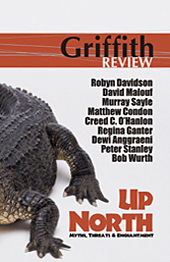WHEN I WAS at primary school in Earlwood, a solid western suburb of Sydney built largely for, and by, Diggers returned from the First World War, “the north” meant the North Shore, a snooty region inhabited by rich people speaking an odd, different language. As, I later learnt, did the Aborigines who had lived on the opposite sides of Sydney Harbour before We arrived. This land of mystery, faintly menacing, could be visited by crossing our newly completed Bridge, the wonder of the world, a trip that also gave us a thrilling glimpse of Pinchgut, or more formally Fort Denison with its fairytale tower far below where, we were told, our convict ancestors had their guts cruelly pinched by a diet of bread and water in full view of le tout Sydney or, in the then more fashionable white-armband view of our history, our British forbears had exposed to public censure the odd boozy lad and lass who had temporarily forgotten our treasured ideals of strong tea, fair play, social deference and hard work.
Then, a few years later, my northern horizons expanded enormously. Like my grandfather and my five uncles, my father, Sydney Duncan Sayle worked for the New South Wales Government Railways (NSWGR), got mail from his office marked OHMS, and had a gold pass that entitled us to low fares and, in my case, a thrilling ride on the footplate of a steam locomotive hauling the night express north, the beefy stoker in a black singlet shovelling coal into a glowing firebox, the driver working a wailing whistle to wake crows in the sleeping bush beside the track, which we railway families learned to call the “permanent way”. Then, as the train panted up a long incline, my sister and I had the privilege of tossing the Sydney papers to the fettlers – maybe they are now called maintenance officers – who raised shovels in greeting as we steamed past. Our destination was Taree, from where we took a “battered service coach” over a rough bush road, and a steam ferry to Forster, now a trendy holiday resort, then a fishing village with a few cottages to rent. Silent pictures were shown on Saturdays in the village hall, with a rope down the aisle to separate Us from the local Aborigines, an arrangement both sides had grown up with. This north was an earthly paradise and, as I soon learnt, north was a direction that could offer us opportunity, even help in need.

Already a subscriber? Sign in here
If you are an educator or student wishing to access content for study purposes please contact us at griffithreview@griffith.edu.au





